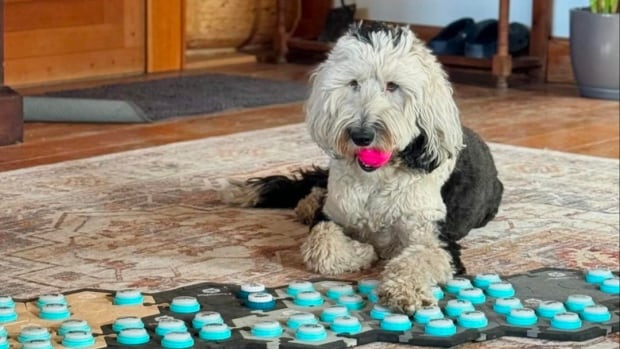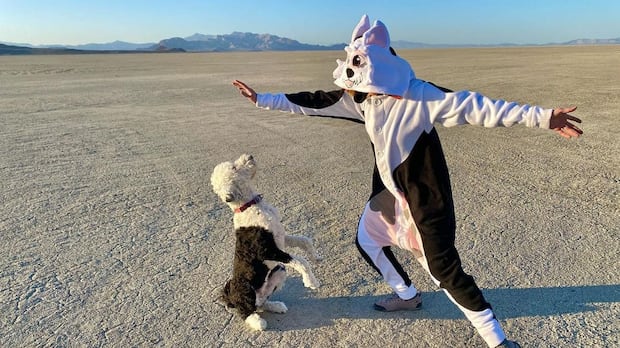The Current19:34Can dogs understand the words we speak?
When Alexis Devine was having a tough time one day, her sheepadoodle dog named Bunny consoled her — just not in a way that most people might expect.
“I was talking to my partner over FaceTime and I was crying … and Bunny pressed ‘no.’ I wasn’t looking at her, I was just engaged in the conversation,” said Devine.
After what seemed like a plea from Bunny for her to not cry, Devine said, “There was a pause, and then she pressed ‘love you.'”
Bunny communicates to Devine, the author of I Am Bunny, through a soundboard device — a floor placemat with pressable buttons for dogs that play pre-recorded words out loud. To date, Devine says Bunny can “speak” about 100 words.
On TikTok, Bunny’s prowess delights over 8.5 million followers, and she is among many other pet dogs on the video-sharing platform — Oski the pug, Copper the Lab, Flambo the Aussie — who are shown to communicate with their owners using soundboards.
As a researcher whose interests include the cognitive abilities of different species, the rise of “talking” dogs further piqued the interests of Federico Rossano, an associate professor in the department of cognitive sciences at the University of California, San Diego.
“My next reaction was like, somebody should study it because I think once you have hundreds, thousands of people doing this [online], we should know what’s going on,” Rossano, who also leads the Comparative Cognition Lab at his university, told The Current’s Matt Galloway.
Published in the journal PLOS ONE last month, Rossano’s findings suggest dogs in the study were able to understand certain words, contributing to the possibility of an enhanced bond between dogs and their owners.
As a dog owner, Devine says the results aren’t unexpected.
“I think it’s not a surprise to anyone who lives with dogs that they can make associations with objects and words.”
What the findings mean
To investigate whether dogs trained to use soundboards actually understand the words that are played when a button is pressed, Rossano and his colleagues conducted two controlled experiments with 59 dogs.
The researchers aimed to rule out variables such as a dog responding to their owner’s cues — like, the owner putting on shoes to go outside — the identity of the human saying the word, or memorizing the location of buttons on the board.
“Part of the new idea or challenge here was that, very often, you might think that the dog understands the word ‘treat.’ But really what the dog sees is you moving towards the cupboard and opening [it],” said Rossano.
“We wanted to show that this animal is actually paying attention to the words, the sounds.”

Daphna Buchsbaum, an assistant professor of cognitive and psychological sciences at Brown University in Providence, R.I., who was not involved in the research, told CBC the study is a first step in “systematically trying to see how the dogs use these buttons, how they respond to them, and if the dogs are actually associating the buttons with particular outcomes in the world.”
“What the researchers found in this case was that for at least some of the meanings, there did seem to be a relationship between the meaning of the words to us as humans and how the dogs responded.”
In Rossano’s study, the button words for the dogs to respond to, included “out/outside,” “play/toy” and “food/eat/dinner/hungry.”
Moving forward, Buchsbaum says it would be interesting to see what would happen if the button words were more abstract, or even existential.
“I think it’s a lot easier to ask questions [like] does the dog understand things about food, outside and playing, than do they understand things about outer space, or the future, or the meaning of life,” Buchsbaum said.

Greater implications
Rossano is realistic about what he has found. At the study’s start, he said that he was skeptical about finding out if dogs were using soundboards in a way that’s more than “using a human as a vending machine.”
However, there were certain times during the studies that caused him to think differently about a dog’s communication and comprehension capabilities — including seeing them negotiate in a human-like way.
He gave the example of how a dog could respond to a human saying that they can’t go outside, and not just settle for the human’s first response.
“I see the dogs doing a ‘back-and-forth’ with the humans,” said Rossano.
Rossano’s research is ongoing, and he sees the current findings and continuing developments in the field as an opportunity to improve the welfare of our pet dogs.
“Hopefully [it] gives them a little more voice and control over their life, having them tell you what they need instead of us just trying to guess it.”
Buchsbaum agrees, and says that enhanced communication could be helpful with dogs who “serve many working roles in our society,” including scent detection dogs and assistance dogs.
Alexis Devine has been teaching her dog, Bunny, to communicate by pressing buttons to “speak” since she was a puppy. Bunny now “speaks” about 100 words and Devine has written a book about the experience. Devine spoke to On the Coast guest host Amy Bell about what it’s like to have a talking dog.
Devine says that Bunny has changed her own expectations of the special relationship that’s possible with a dog.
“We’ve got beautiful communication both with, and without, the buttons. I think her having the buttons really allowed me to more intentionally interpret aspects of her body language, and it definitely made me a better active listener,” she said.
“In order to add words that were salient to her experience that she was going to want to use, I really had to pay attention to the things she was smelling and looking at, and things that caused any sort of emotional arousal within her.”



